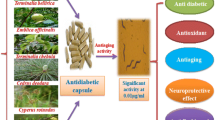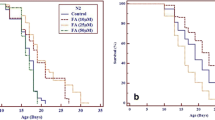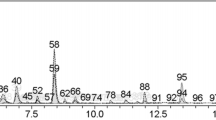Abstract
Enhanced blood glucose levels are a hallmark of diabetes and are associated with diabetic complications and a reduction of lifespan. In order to search for plant extracts that display preventive activities in such a scenario, we tested 16 extracts used in human nutrition for their survival enhancing activities in the nematode Caenorhabditis elegans. Nematodes were exposed for 48 h to 10 mM glucose in the absence or presence of 0.1 % extract. Thereafter, survival was measured at 37 °C. Extracts made from coffee, kola, rooibos and cinnamon, did not influence the glucose-induced reduction of survival. Those made from ginseng, camomile, lime blossom, paraguay tea, balm, rhodiola, black tea, or knotgrass all extended the lifespan of the glucose-treated nematodes significantly but did not rescue survival completely. Extracts from the leaves of blackberries, from hibiscus, elderberries, or jiaogulan completely countered the glucose-induced survival reduction. A potent activation of the proteasome was shown for the most preventive extracts suggesting a more efficient degradation of proteins impaired by glucose. In conclusion, we present a simple animal model to screen for plant extracts with potency to reverse glucose toxicity. Extracts from blackberry leaves, hibiscus, elderberries, and jiaogulan were identified as very potent in this regard whose exact mechanisms of action appear worthwile to investigate at the molecular level.





Similar content being viewed by others
Abbreviations
- AA:
-
Ascorbic acid
- AGEs:
-
Advanced glycation end products
- ER:
-
Endoplasmic reticulum
- MG:
-
Methylglyoxal
- NGM:
-
Nematode growth medium
- Suc-LLVY-AMC:
-
Succinyl-leucyl-leucyl-valine-aminomethyl-coumarine
References
Monnier L, Colette C, Owens D (2012) The glycemic triumvirate and diabetic complications: is the whole greater than the sum of its component parts? Diabetes Res Clin Pract 95:303–311
Preuss HG (1997) Effects of glucose/insulin perturbations on aging and chronic disorders of aging: the evidence. J Am Coll Nutr 16:397–403
Mooradian AD, Thurman JE (1999) Glucotoxicity: potential mechanisms. Clin Geriatr Med 15:255
Beal MF (2002) Oxidatively modified proteins in aging and disease. Free Radic Biol Med 32:797–803
Semba RD, Nicklett EJ, Ferrucci L (2010) Does accumulation of advanced glycation end products contribute to the aging phenotype? J Gerontol A Biol Sci Med Sci 65:963–975
Newsholme P, Gaudel C, Krause M (2012) Mitochondria and diabetes. An intriguing pathogenetic role. Adv Exp Med Biol 942:235–247
Fitzenberger E, Boll M, Wenzel U (2013) Impairment of the proteasome is crucial for glucose-induced lifespan reduction in the mev-1 mutant of Caenorhabditis elegans. Biochim Biophys Acta 1832:565–573
Elosta A, Ghous T, Ahmed N (2012) Natural products as anti-glycation agents: possible therapeutic potential for diabetic complications. Curr Diabetes Rev 8:92–108
Wu CH, Huang SM, Lin JA, Yen GC (2011) Inhibition of advanced glycation endproduct formation by foodstuffs. Food Funct 2:224–234
Brenner S (1974) The genetics of Caenorhabditis elegans. Genet Dev 77:71–94
Stiernagle T (2006) Maintenance of C. elegans. WormBook 1-11
Gill MS, Olsen A, Sampayo JN, Lightgow GJ (2003) An automated high-throughput assay for survival of the nematode Caenorhabditis elegans. Free Radic Biol Med 35:558–565
Pispa J, Palmén S, Holmberg CI, Jäntti J (2008) C. elegans dss-1 is functionally conserved and required for oogenesis and larval growth. BMC Dev Biol 8:51
Tsai YC, Lin CL, Chen BH (2010) Preparative chromatography of flavonoids and saponins in Gynostemma pentaphyllum and their antiproliferation effect on hepatoma cells. Phytomedicine 18:2–10
Hager H (2012) Hagers handbuch der pharmazeutischen praxis. Springer, Hager-ROM, Berlin
Raynes R, Leckey BD Jr, Nguyen K, Westerheide SD (2012) Heat shock and caloric restriction have a synergistic effect on the heat shock response in a sir2.1-dependent manner in Caenorhabditis elegans. J Biol Chem 287:29045–29053
Frank T, Janssen M, Netzel M, Strass G, Kler A, Kriesl E, Bitsch I (2005) Pharmacokinetics of anthocyanidin-3-glycosides following consumption of Hibiscus sabdariffa L. extract. J Clin Pharmacol 45:203–210
Liu F, Ren D, Guo DA, Pan Y, Zhang H, Hu P (2008) Method development for gypenosides fingerprint by high performance liquid chromatography with diode-array detection and the addition of internal standard. Chem Pharm Bull 56:389–393
Martinez-Vicente M, Sovak G, Cuervo AM (2005) Protein degradation and aging. Exp Gerontol 40:622–633
Lin CY, Yin MC (2012) Renal protective effects of extracts from guava fruit (Psidium guajava L.) in diabetic mice. Plant Foods Hum Nutr 67:303–308
Soman S, Rauf AA, Indira M, Rajamanickam C (2010) Antioxidant and antiglycative potential of ethyl acetate fraction of Psidium guajava leaf extract in streptozotocin-induced diabetic rats. Plant Foods Hum Nutr 65:386–391
Naowaboot J, Pannangpetch P, Kukongviriyapan V, Kongyingyoes B, Kukongviriyapan U (2009) Antihyperglycemic, antioxidant and antiglycation activities of mulberry leaf extract in streptozotocin-induced chronic diabetic rats. Plant Foods Hum Nutr 64:116–121
Acknowledgments
We greatly acknowledge Mr. Alan McDonley for critical reading of the manuscript.
Conflict of Interest
The authors declare that they have no conflict of interest.
Author information
Authors and Affiliations
Corresponding author
Rights and permissions
About this article
Cite this article
Fitzenberger, E., Deusing, D.J., Wittkop, A. et al. Effects of Plant Extracts on the Reversal of Glucose-Induced Impairment of Stress-Resistance in Caenorhabditis elegans . Plant Foods Hum Nutr 69, 78–84 (2014). https://doi.org/10.1007/s11130-013-0399-0
Published:
Issue Date:
DOI: https://doi.org/10.1007/s11130-013-0399-0




